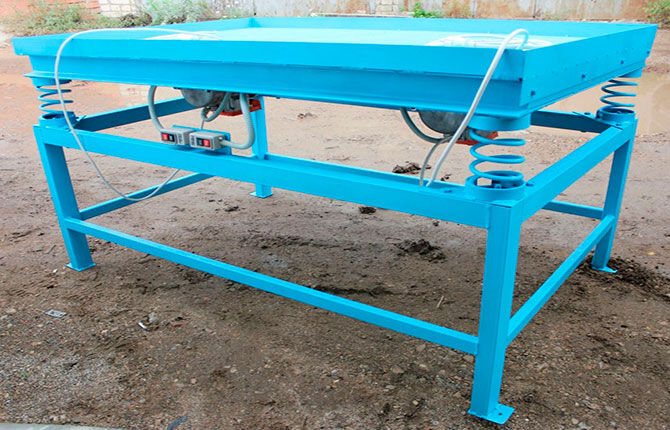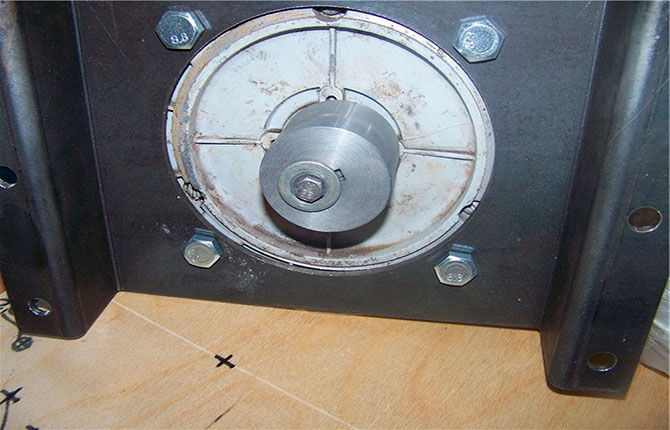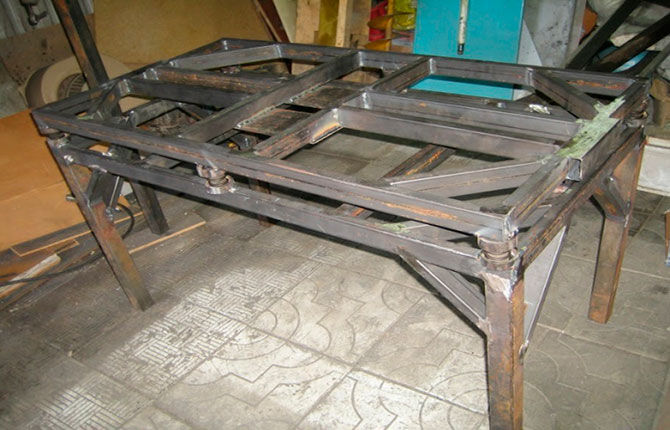How to make a vibration table with your own hands - step-by-step instructions
When making products from concrete, gypsum and other building mixtures, a vibrating table is used.You can assemble it for household needs yourself. Before making a vibrating table, a detailed drawing is created and the necessary tools and materials are prepared.
The content of the article:
Basic design
A vibrating table is a surface designed for compacting building mixtures.
Industrial and household vibrating tables have the same operating principle. With their help, paving slabs, cinder blocks, gypsum blocks, etc. are made. During the vibration process, the building mixture is compacted and follows the contours of the form. At the same time, air bubbles come out of the solution, which makes the product durable.
The vibrating table consists of several elements:
- Bed. Heavy metal structure with brackets for attaching the vibration table to the floor. The bed is a stationary part of the equipment.
- Tabletop. Surface made of sheet metal. Along its edges there are sides that prevent the forms from slipping when the vibrating table is in operation.
- Elastic pillows. Use springs or rubber parts.
- Engine. To make a vibration table yourself, select an asynchronous motor running on a 220-volt AC network.
- Eccentric. The shape and weight of the element with a shifted center of gravity are selected separately for each vibrating table.
- Control block. To turn on the electric motor, a starting device and a switch are installed on the vibration table.
The bed is fixedly attached to the floor. In the upper part, the working surface is fixed to it through spring elements.An electric motor with an eccentric on the shaft is attached to the tabletop. When turned on, the eccentric creates vibrations and transmits them to the surface. The frequency and strength of vibrations depends on the speed of the electric motor and the weight of the eccentric.
You can make a vibration table at home yourself. This requires minimal technical knowledge and welding experience. By following the sequence of actions, you will be able to make a vibrating table.
We bring to your attention an article about how to do andDIY inversion table.
Required materials and tools
Before making a vibrating table for tiles, cinder blocks and other products, prepare the material and tools. The list may differ and is selected separately in each case. To work you will need:
- A metal sheet. The minimum thickness depends on the type of frame. The thinner the sheet, the more massive the sheathing needs to be made.
- Corner for sides.
- Profile pipe, channel, rod, etc. for making a frame.
- Movable elements. They use metal springs, pieces of rubber or cushions designed to mount a car engine.
- Electric motor. The power is selected based on the size of the vibrating table. For domestic needs, an electric motor with a power of up to 1 kW is sufficient.
- Welding machine. The surfaces are connected by welding of any type.
- Electric drill and set of metal drills.
- Angle grinder with cutting discs.
- Electric motor of required power.
- Control block.
- Fastening elements.
- Plastic clamps.
- Eccentric.Eccentric
Manufacturing of structural elements
Before you make a vibration table yourself, you should draw up a detailed drawing.This way it will be possible to calculate the amount of material and take into account the nuances of the design at the development stage.
You can use ready-made drawings of a vibrating table. During work, strictly adhere to the specified dimensions.
bed
To make the base, 4, 6 or 8 metal pipes are installed vertically. They are welded together with transverse strips or corners. Select a flat area for work. The top and bottom edges of the pipes must be in the same horizontal plane. To do this, use a water building level.
At the bottom, pieces of sheet metal are attached to the legs. Holes are made in them for fastening to the floor covering. On the other side, glasses made from pipe scraps or brackets for attaching elastic cushions are installed on the legs.
A box is mounted on one of the sides for mounting the control unit. The height of the location is selected so that the operator does not bend over the buttons when working.
The vibrating table is attached to the floor covering. To avoid displacement of the equipment when compacting building mixtures, the legs are securely fixed to the floor with anchors. Under the influence of vibration, threaded connections spontaneously unscrew. To eliminate this, install a locking washer under the anchor nut.
Elastic elements
Spring parts are installed in the upper part of the frame. The fastening method is selected based on the type of element. Metal springs are mounted in glasses. car airbags are screwed on with a threaded connection. At this stage, several rules are followed:
- The length of the springs must be the same. Skewing the top surface will cause the molds to slip during operation. It will be impossible to use the vibration table.
- When fixing the elastic elements, screw nuts are installed.
- The height of the springs should be sufficient to ensure that the top surface and the frame do not come into contact with each other under the influence of the weight of the building mixtures on the vibrating table.
Eccentric
Oscillatory movements are transmitted to the vibrating table from a motor with an eccentric on the rotor shaft. It is a part with a displaced center of gravity. When the armature of an electric motor rotates under the influence of centrifugal force, vibrations are generated. The force of vibrations transmitted to the vibrating table is changed by shifting the center of gravity. You can make the details yourself:
- Cut out 2 ovals from sheet metal 8-10 mm thick.
- Connect the workpieces together. In this case, use a clamp or vice.
- Drill holes for attachment to the rotor shaft. The holes are not located in the center of the parts, but offset.
- Using a compass, draw a line at the same distance from the hole made.
- Drill several holes along the line. They are needed to secure the ovals with a threaded connection.
After this, install the parts on the armature of the electric motor. During operation, the center of gravity of the eccentric is changed by shifting one shaft relative to the other.
Manufacturing and installation of a vibrating platform
The upper surface of the vibrating table must be made of a flat sheet. Rigidity is imparted to the structure by making the sheathing from a profile pipe, angle, channel, etc.
The rigidity of the tabletop is necessary to eliminate high noise levels during use.
It is recommended to make a border around the perimeter of the tabletop. Its height is 30-60 mm and is selected separately. A corner is used to make the side. It is attached to the tabletop by welding or threaded connections.
In the center of the table top lathing, a bracket is made for mounting the electric motor. At the same time, the quality of the welds is monitored. The joints between the unit and the sheathing are subject to high loads. Poor quality welds will lead to failure of the compacting equipment.
The vibration platform is mounted on movable pads with the engine facing down. The springs are attached to the tabletop. When installing the vibrating platform, make sure that the surface is positioned correctly in the horizontal plane.
After connecting the table parts, the power wires of the unit are attached. To avoid breakage due to vibration, the wiring is fixed to the structure with clamps. In this case, the wire is located with sagging between the upper and lower parts of the product. The presence of a loop compensates for vibrations in the upper part. The starting device and control buttons are placed in a box.
Motor selection
The power of the unit is selected based on the size of the table. Single-phase asynchronous motors with an operating voltage of 220 V are suitable for home use.
In some cases, electric motors from used household appliances are used to make a vibrating table.
To increase functionality, the engine control unit is equipped with a speed controller. This is how the intensity of vibrations is changed for different building mixtures.
When choosing an electric motor, pay attention to the reliability of the rotor bearings. When the table is in operation, there is a load on the bearings. Under the influence of vibration, the seats wear out.
The simplest design
Making a vibrating table is not practical if you need to make several cinder blocks or slabs. You can compact the building mixture in a mold using a simple design. For this:
- Spring elements are attached to the surface. These are rubber cushions, springs, car tires, etc.
- A shield made of wood or metal is placed on top.
- Place forms with building mixture.
- Create oscillatory movements of the shield. To do this, tap the surface with a hammer. The intensity of oscillatory movements is increased with a drill in hammer drill mode. The chuck of a power tool rests against a shield to transmit vibration.
This way it is possible to make the contents of the mold sufficiently dense without using a vibrating table with an electric motor.
Finally
You can make a vibration table at home with your own hands. It is important to choose the correct technical characteristics of the electric motor. You can change the intensity and force of oscillatory movements by shifting the center of gravity of the eccentric and adjusting the engine speed.
At the initial stage, a detailed drawing is created with a description of the dimensions. During production, personal protective equipment is used (goggles, welding shield, gloves, etc.). This way you can avoid burns and injury.
Do you use a vibrating table for compaction? concrete? Do you use a ready-made design or make it yourself? How does your equipment work? If you found the article useful, repost it on social networks and bookmark it.
The video shows the process of making a homemade vibrating table:
Do-it-yourself grounding device in a private house, the procedure for carrying out installation work. You can read about this on our website link.







